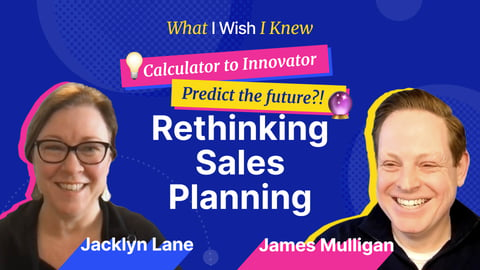*As seen on Forbes.com
If you’ve ever felt the sting of disappointment, the age-old quote of, “a goal without a plan is just a wish” has likely come to mind. Maybe you’ve had a pitch fall flat in a client meeting or had to report a gloomy sales forecast. Or even worse, navigate hiring freezes or layoffs. You set a goal, but somewhere along the line, things fall off track.
The result? You and your team end up defeated. More and more, sales organizations around the globe are finding themselves in this disappointing, regrettable state, where revenue goals are promised, but not delivered.
Sure, we can blame the volatile economy and unpredictable market trends. But while others are pointing fingers, innovative revenue leaders are thriving. How? By building a more connected path to predictable revenue and creating adaptable plans that tee their sales organizations up for success, regardless of the challenges that stand in their way.
It's Broken. Fix It.
Most sales leaders are good at communicating goals and objectives, including net-new sales, margin, profitability, or customer retention. There are many flavors of revenue goals, but they are generally straightforward. These goals get trickled down across the sales organization through sales plans designed to help sellers achieve those objectives, such as territories, quotas and targets, sales incentive programs, for example.
But, according to the Alexander Group Institute, only 28% of salespeople are confident they are going to hit their quota in 2023. So clearly, things are being lost in translation. Why is this happening more often, despite so many well-intended efforts? And, more importantly, how can you be different?
In the 20th century, go-to-market strategy has been a concept primarily set aside as an annual exercise for top leadership in closed-door meetings where the direction of the sales organization is set. Marching orders are then communicated to the sales team who goes forth and delivers or not.
What if these plans are not the right plans? Or, what if they were the right plans at the beginning of the fiscal year, but now things have changed, and the plans no longer lead to desired outcomes? According to Harvard Business Review, only 29% of revenue leaders feel like they have an effective go-to-market strategy in place. So clearly, the plans being built and delivered by most organizations are not setting sellers up for success.
Investing in Go-to-Market Strategy
Top-performing revenue teams are taking a more connected, more purposeful approach. They’re innovating on how they invest in their go-to-market strategy and prioritizing it like most organizations traditionally focus on the day-to-day efforts of their sellers.
There is no shortage of investment options for sales teams; setting goals and quotas, increasing coaching efforts, enablement, marketing events and promotions, sales contests and SPIFFs, technology purchases, talent hiring, entering new markets, and more.
But what does the investment behind all these efforts look like? How are these decisions made at your organization today? Are these coordinated, well-orchestrated decisions that can quickly evolve as market conditions dictate, or does it look more like a toddler t-ball game?
Re-Thinking Your Path to Revenue
Broadly, regardless of size and complexity, most sales organizations fundamentally work the same: define goals >> build plans >> execute (sell) >> deliver revenue. But what if a stronger focus on strategy can help you unlock stronger, more reliable seller performance and get you more reliably to your revenue goals? At Varicent, we’re helping our customers build more connective tissue between go-to-market strategy and execution.
Building Plans for Go-to-Market Resiliency
The more adaptable your sales plans are, the more you can successfully manage changes throughout the year and help your sales organization course correct. The only way you can do that is by being able to quickly identify gaps in your plans, measure and weigh trade-offs, and quickly deploy changes.
Whether you’re considering how to fill a territory gap or adjust a revenue target for a new product, these plans and decisions are part of a connected ecosystem. As you build and create your strategy, you need to do it in a connected, collaborative way. Once decisions are made, you need to be able to quickly deploy and effectively communicate your plans.
The more transparency you provide, the more trust you build. When sellers have a clear line of sight of what their plans are, they’re more likely to align their behaviors with the objective you’ve aligned to the plans.
For most organizations, planning cycles are still infrequent. At most, they happen quarterly. And too much change will frustrate and confuse sales teams. But the monitoring and fine tuning of your strategy should be happening constantly. This is when you truly become agile in your approach. And is where technology plays a critical role. Most organizations want to get more proactive, but it is really hard to do without the right data and tools.
Igniting a Transformation Starts with a Spark
Transforming how you build and execute your go-to-market strategy begins with exploration and conversation. Some questions to think about include:
- What are the gaps in your current sales plans (market and account segmentation, territories, quotas and targets, sales incentive programs, etc.) today?
- How connected are the people, processes, and data across these efforts?
- Who are the strategic partners across your organization (for example, sales, operations, finance, and additional revenue support teams) that can help you build a more connected strategy?
- What is holding you back from a more connected approach today (tech, culture, resources)?
Learn more about the practical steps sales and revenue leaders and operations team are taking to start their journey to a more connected go-to-market strategy with the eBook; Helping Revenue Leaders Drive Growth: Five Actions to Ensure Sales Leadership Success.
.png?width=75&height=75&name=Ellipse%2047%20(1).png)


